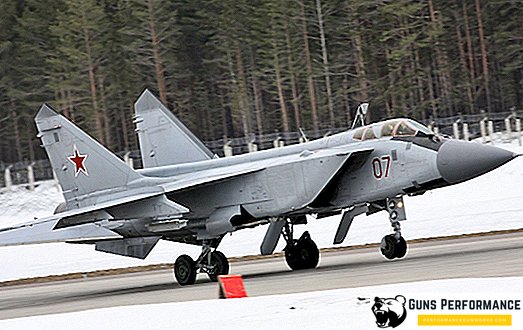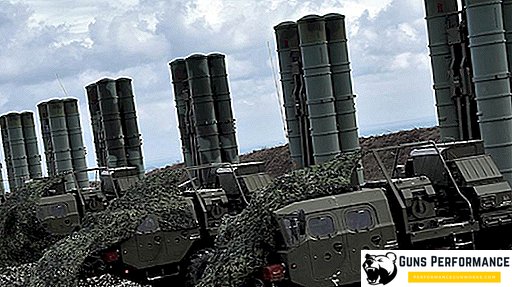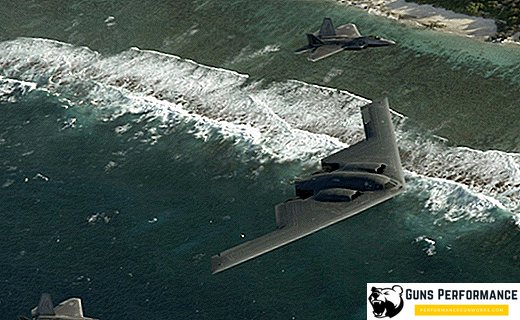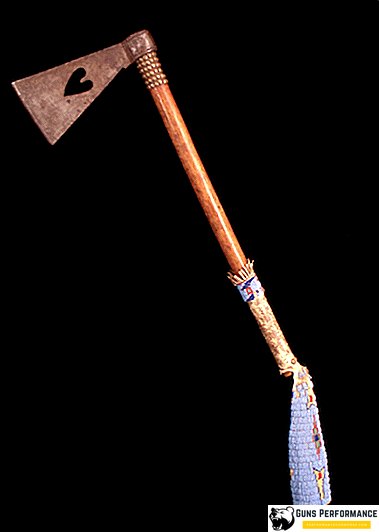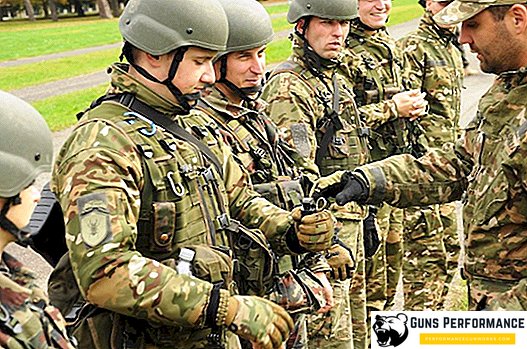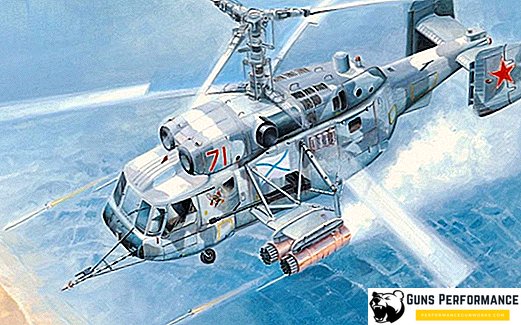
The Ka-27 is a Soviet carrier-based multi-purpose helicopter developed at the Kamov Design Bureau in the 1970s. It was adopted in 1981. The first flight of the prototype took place in 1973, then two basic modifications of the helicopter were created at its base: the Ka-27PL and Ka-27PS.
The Ka-27PL was designed to combat enemy submarines, and the Ka-27PS was designed to conduct search and rescue operations at sea.
The helicopter can search and detect enemy submarines, following at depths of up to five hundred meters at a speed of 75 km / h at a distance of 200 km from the ship-based. The Ka-27 can perform its combat missions in adverse weather conditions, day or night, when the sea is up to five points.
When creating the Ka-27, the experience of developing and operating another Kamov machine, the Ka-25 ship-based helicopter, was actively used.

The serial production of the Ka-27 began in 1977, a total of 273 machines were manufactured. This helicopter is still in service with the Russian Navy and the Border Guard Service of the Russian Federation. Also, it is operated by the naval forces of Ukraine. In addition, over the years, these machines were exported to India, China, Yugoslavia and Syria.
The history of the creation of the Ka-27
The creation of helicopters for the Soviet Navy traditionally engaged in the design office of Kamov. Their first offspring, the Ka-10 and Ka-15, can hardly be called successful machines, only the Ka-25, put into service in 1971, can be called the first full-fledged Soviet anti-submarine helicopter, but this machine also had significant drawbacks.
The Ka-25PL began to enter the fleet in 1966, they were armed with a BOD of Project 61 and a cruiser of Project 1123. According to its characteristics, this helicopter came close to similar vehicles in service with foreign fleets, but it could not compare with them.
In 1970, the Soviet Union conducted the grandiose naval exercises "Ocean", which clearly showed the main shortcomings of the Ka-25. Among them should be attributed a small carrying capacity and a very modest radius of action of this helicopter - it could be removed only fifty kilometers from the aircraft carrier and be in flight for just over an hour. In addition, the reliability of this machine also left much to be desired: the Ka-25 was considered one of the most emergency aircraft of the Soviet naval aviation - in a relatively short period of operation more than two dozen catastrophes occurred to it.

At the same time, the operation of these helicopters showed their significant role in the anti-submarine defense system of warships and ship formations. These machines proved themselves very worthy when searching for and tracking enemy submarines and allowed seafarers to develop clear and reasonable requirements for this class of aircraft.
Based on the foregoing, it is not surprising that as early as 1969, the Kamov design bureau began work on creating a new deck helicopter with more advanced characteristics. And on May 15, 1970, the meeting of Admiral Gorshkov, the Commander-in-Chief of the Soviet Navy, with the chief designer of Soviet naval helicopters N. I. Kamov, at which the future machine was discussed, took place. It should be noted that Gorshkov was an ardent supporter of the further development of naval aviation; therefore, during his leadership of the fleet, such projects received full support.
During this period, in the Soviet Union, work was being done on the creation of fundamentally new ships — heavy aircraft-carrying cruisers of Project 1143. They needed a new deck helicopter that would have higher flight-technical characteristics.
First of all, the military needed a helicopter with a greater range (up to two hundred kilometers) and a payload capacity. To effectively use the hydroacoustic stations, it was necessary to improve the vibration characteristics of the helicopter, as well as to provide the machine with high accuracy while hovering over the water surface.

During the search for enemy submarines or conducting rescue operations, the helicopter performs rather complicated maneuvers, so another requirement for the new machine was to provide it with automatic stabilization and control systems. In addition, the new helicopter had to have high reliability and to continue flying even if one of the engines failed.
Also, the military expressed wishes for the protection of the helicopter from the effects of sea water and electromagnetic radiation on the equipment of the vehicle and crew.
The experimental machine received an index of "252" (according to other information Ka-252). In July 1973 a meeting of the mock-up commission was held, at which it was represented. Compared with the Ka-25, it had much higher performance, but at the same time, it was inferior to the latest American anti-submarine helicopter SH-3D, which many participants in the meeting seemed unacceptable.
Ka-252 collected in itself all the best and most modern that at that time could offer the Soviet military-industrial complex. It was equipped with new more powerful and reliable TVZ-117 engines, which increased the power to the machine by 1.7 times. This made it possible to increase the range of the helicopter to 200 km and increase its carrying capacity to 5 thousand kg.
Great interest was aroused by the Octopus sighting and search complex, which was an order of magnitude superior to the Baikal PPS mounted on the Ka-25. On the Ka-252 they planned to install a new GUS with higher characteristics than on the Ka-25. In addition, the new machine received the Privod-SV-Bort complex, which, together with the navigation complex and other equipment, could solve a wide range of tasks related to the control of the helicopter in different flight modes. This greatly simplified the work of the crew.
The new helicopter could easily carry out its basic tactical and additional tasks both alone and as part of a compound. Therefore, after some deliberation, the commission recognized that the domestic industry would not be able to create anything better, so the helicopter should be adopted. Comparison with foreign counterparts was considered incorrect.

On August 8, 1973, an experimental car first flew into the air. The first flight of the helicopter in a circle occurred in December of the same year, but later on the test dates were often delayed. Their first stage took more than four years, after its completion it was decided to start the serial production of the helicopter. He was established at a plant in the city of Kumertau.
During the first and second stages of testing at the car were found numerous flaws and inconsistencies with the initial requirements of the customer. Their elimination required a lot of time, so only on April 14, 1981 the helicopter was put into service and received the designation Ka-27.
For the creation of a new machine, the development team was awarded the Lenin Prize.
In the combat unit Ka-27 began to arrive in 1979. The pilots who previously piloted the Ka-25 easily mastered the new car.
Currently, the Ka-27 is part of the armament of the Admiral Kuznetsov TAKR, there are one helicopter each aboard the Project 956 destroyers and Project 1164 cruisers and two Project 1144 cruisers and the Project 1155 BOD each.
The construction of the Ka-27
The Ka-27 helicopter is made according to a twin-screw coaxial scheme. It has two engines and four landing gear. The Ka-27 screws are three-bladed, of opposite rotation, while staying on the ship they are folded up like a fan. The blades of the blades are made of titanium, and the blades themselves are made of fiberglass.

The helicopter's fuselage is all-metal, it is made of aluminum alloys. In its front part is the crew cabin and cargo cabin. The design of the fuselage is largely similar to the Ka-25, but differs in somewhat larger size and capacity.
The helicopter chassis is non-retractable, has four racks. Front wheels are self-guided. On the Ka-27 you can install skis. For carrying out an emergency landing on the water there are two ballonets, which are located on the sides of the fuselage. They can be filled with air from special cylinders in five to six seconds. After landing on them, the helicopter is able to float for some time. It is enough to evacuate the crew.
The structure of the power plant Ka-27 includes two turboshaft engines TV3-117KM (2х2200 hp) and a gearbox. The engines are mounted at the top of the fuselage.
The power source for the onboard equipment are two AC devices driven by a gearbox.
The helicopter has an autopilot, radio compass. The Ka-27 anti-submarine helicopter has a crew of three people - a pilot, navigator and operator of anti-submarine systems. The crew of the search and rescue vehicle modification includes four people: a pilot, a navigator, a technician and a paramedic rescue.

The Ka-27 helicopter is equipped with a very modern (for its time) navigation and flight equipment. The Ka-27 anti-submarine equipment consists of the Octopus automated search and sighting system, as well as autonomous search tools, which include the Pakhra receiving-indicator device and a magnetometer. The helicopter can take on board 36 buoys.
The most important part of the helicopter search system is the Octopus PTS, which can detect submarines in any position, calculate their coordinates, calculate the machine’s hangup points when working with the sonar station, evaluate the overall navigation and tactical situation, and process data on the use of onboard armament.
PPS "Octopus" includes:
- A radar station that provides a solution to navigation tasks and is able to detect enemy submarines in surface position. Its fairing is located in the nose of the machine.
- Lowering sonar station, which is located at the rear of the fuselage. It is designed to detect submarines underwater.
- A computing device that automatically leads a helicopter to the point of discharge of weapons.
PPS "Octopus" has a digital computer, it is associated with the system "Drive-SV-board", with a torpedo and bomber armament of a helicopter.
The Ros-V hydroacoustic station can detect enemy submarines either by sending a signal and receiving its reflection, or by capturing the noise that the submarine makes when it moves.
The helicopter is capable of dropping markers, radio beacons and smoke generators.
The Ka-27PL armament consists of anti-submarine torpedoes AT-1MV, APR-23 missiles and free-fall PLAB bombs of various calibers.
Modifications of the Ka-27 helicopter
Ka-27PL and Ka-27PS are the most common modifications of this machine. Ka-27PS is designed to conduct search and rescue operations, as well as to search for space descent vehicles. The crew of this helicopter consists of four people, there are some differences in the onboard equipment.
Further development of the rescue modification is the Ka-27PDS helicopter. It has a take-off weight increased to 12 thousand kg, which allows it to take more fuel and stay in the air longer.
Ka-28 is an export modification of the helicopter. Since 1986, this machine has been actively supplied to the Navy of other states.
Ka-29. This is a transport vehicle created for the Marine Corps.

Ka-31. A long-range radar detection helicopter equipped with a rotating antenna under the fuselage. It can find targets at distances up to 100 km and accompany 20 objects at once.
Ka-32. Another modification of the helicopter rescue model. It was created for civilian use, taking into account all the experience of using the Ka-27PS and Ka-27PL. This machine is highly reliable and relatively low cost, therefore, is in high demand in the international market. This helicopter was certified according to international standards and is delivered to Switzerland, Canada, Malaysia and South Korea.

Ka-27E. This is a very interesting modification, developed in the Soviet Union. This helicopter is designed for remote monitoring of the presence of radioactive materials on board ships.
Characteristics of TTK Ka-27
Below are the characteristics of the Ka-27PL helicopter:
- crew - 2-3 people;
- engine - 2 x GTE TV3-117;
- diameter of rotors - 15.9 m;
- fuselage length - 11.3 m;
- height - 5.4 m;
- take-off weight: 11,000 kg;
- Max. speed - 270 km / h;
- ceiling - 4300 m;
- flight range - 800 km.




